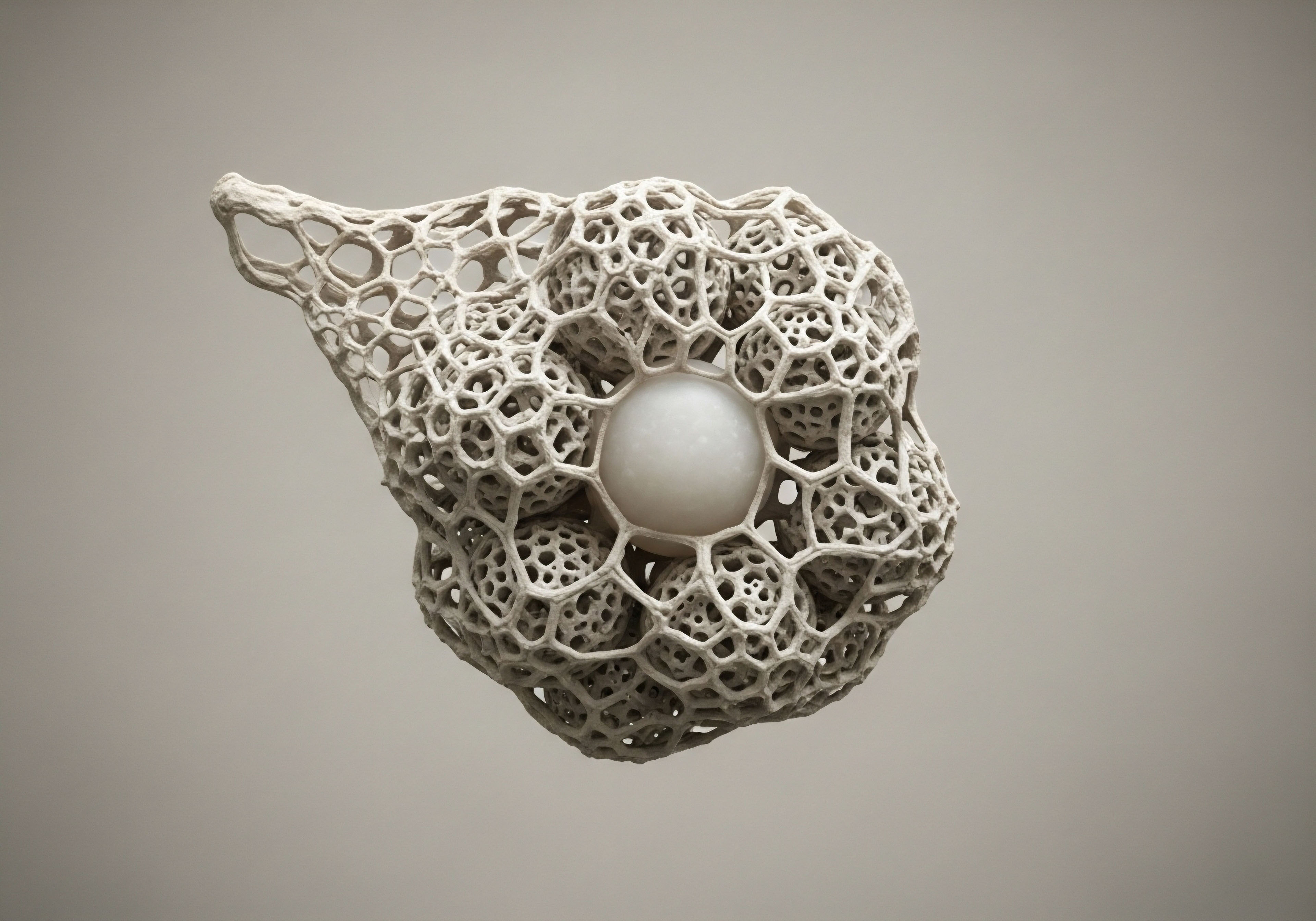

Fundamentals
The feeling is a familiar one for many ∞ a sense of disconnect where the mind’s desire and the body’s response seem to operate in different realms. You may experience a cognitive interest in intimacy, a psychological readiness, yet the physical echo is faint or absent.
This experience is valid, and it points toward a profound biological truth. Your body operates as an integrated system, a seamless network of communication where thoughts, emotions, and physical reactions are inextricably linked. Understanding this network is the first step toward recalibrating your own systems for vitality and function.
At the center of this network is the body’s master communication grid, the neuroendocrine system. This intricate web connects your central nervous system, the seat of your thoughts and perceptions, to your endocrine glands, which produce and release hormones.
Think of hormones as long-range messages, broadcast throughout the bloodstream to coordinate large-scale activities like metabolism, growth, and reproductive cycles. Within this grand system exist peptides, which function as highly specific, short-range couriers. These small chains of amino acids act as precise keys, designed to fit specific locks, or receptors, on the surface of cells. Their role is to deliver targeted instructions, initiating very specific cellular actions in a localized area.

The Great Communicators Your Body’s Internal Orchestra
The orchestration of sexual wellness relies on a constant, flowing dialogue between the brain and the body. This dialogue is managed by a specific command line known as the Hypothalamic-Pituitary-Gonadal (HPG) axis. The hypothalamus, a small region at the base of the brain, acts as the conductor.
It senses the body’s internal and external environment and sends out peptide signals, most notably Gonadotropin-Releasing Hormone (GnRH), to the pituitary gland. The pituitary, in turn, releases hormones that travel to the gonads (the testes in men and ovaries in women), instructing them to produce the primary sex hormones like testosterone and estrogen.
These hormones then circulate throughout the body, influencing tissues from muscle and bone to the brain itself, and also send feedback signals back to the hypothalamus to modulate the entire process. This is a dynamic feedback loop, a biological conversation that maintains equilibrium.
When we discuss sexual wellness, we are truly discussing the efficiency and clarity of this conversation. A disruption at any point in the HPG axis can create a cascade of effects. For instance, chronic stress can suppress hypothalamic function, quieting the initial signals.
Age-related changes can alter the sensitivity of the pituitary or the production capacity of the gonads. These are physiological realities that manifest as both physical symptoms, such as low energy or changes in body composition, and psychological ones, including diminished desire or a muted sense of well-being. The system itself does not distinguish between the mind and the body; it perceives only signals and responses. Therefore, a solution must also address the system as a whole.

Signaling Molecules the Keys to Function
Peptides represent a sophisticated therapeutic approach because they are designed to speak the body’s native language. They are signaling molecules that can directly interact with specific parts of the neuroendocrine system to restore or enhance communication. Some peptides are engineered to act centrally, directly within the brain, to influence the very origins of desire and arousal.
They can bind to receptors in the hypothalamus or other limbic areas associated with emotion and motivation, effectively turning up the volume on the initial signals that spark sexual interest. This is a direct intervention at the level of psychological experience, initiating a cascade that flows downward to the rest of the body.
Peptides function as precise biological messengers that can directly enhance the communication between the brain and body essential for sexual health.
Other peptides work on a more foundational level. They support the body’s overall systemic health, ensuring the physiological environment is optimized for a healthy sexual response. For example, certain peptide combinations can enhance the release of growth hormone, which plays a vital role in cellular repair, metabolic function, and maintaining healthy body composition.
By improving sleep quality, reducing inflammation, and optimizing energy metabolism, these peptides ensure the body’s machinery is well-maintained and responsive. This systemic support creates a robust foundation upon which the centrally-acting peptides can build, ensuring that when the brain sends a signal of desire, the body is fully equipped to receive it and respond.
The true potential of peptide therapy lies in the intelligent combination of these approaches. By pairing a peptide that enhances central nervous system pathways of desire with another that optimizes the body’s metabolic and cellular health, it becomes possible to address both the psychological and physical dimensions of sexual wellness simultaneously.
This integrated strategy acknowledges the biological reality that mind and body are one unified system. The goal is a recalibration of the entire network, fostering a state where psychological desire and physiological response are once again synchronized, leading to a complete and fulfilling experience of sexual vitality.


Intermediate
Moving beyond foundational concepts, we can examine the specific clinical tools used to recalibrate the systems governing sexual function. Peptide protocols are designed with a deep understanding of the body’s signaling pathways, targeting precise mechanisms to achieve specific outcomes.
The effectiveness of these protocols comes from their specificity, acting on the very receptors that initiate the cascades of sexual desire and physical arousal. Two of the most significant peptides in this domain are Bremelanotide (PT-141) and Kisspeptin, each with a unique mechanism of action. When used thoughtfully, sometimes in conjunction with foundational therapies, they can comprehensively address the complex nature of sexual wellness.

PT-141 a Central Catalyst for Desire
Bremelanotide, widely known as PT-141, operates directly within the central nervous system. Its primary function is to activate melanocortin receptors, specifically the MC3R and MC4R subtypes, which are densely populated in the hypothalamus and other limbic areas of the brain. These regions are deeply involved in regulating mood, motivation, and sexual behavior.
When PT-141 binds to these receptors, it initiates a neurochemical cascade that leads to an increase in dopamine release. Dopamine is a critical neurotransmitter associated with the brain’s reward and pleasure centers, and its elevation is directly linked to heightened motivation and desire.
The action of PT-141 is what makes it a powerful tool for addressing the psychological component of sexual wellness. It directly stimulates the neural pathways responsible for generating sexual interest. This is why it received FDA approval for the treatment of Hypoactive Sexual Desire Disorder (HSDD) in premenopausal women, a condition characterized by a distressing lack of sexual fantasies and desire.
For both men and women, the experience of using PT-141 is often described as a cognitive and emotional shift, a reawakening of sexual thoughts and interest that precedes any physical response. The therapy is typically administered via a subcutaneous injection or a nasal spray, with effects beginning within a few hours and potentially lasting for a significant duration, offering a window of enhanced sexual readiness.

Kisspeptin the Master Regulator of the Reproductive Axis
While PT-141 acts on the brain’s desire circuits, Kisspeptin functions as a master regulator of the entire Hypothalamic-Pituitary-Gonadal (HPG) axis. Kisspeptin is a naturally occurring peptide that governs the release of Gonadotropin-Releasing Hormone (GnRH) from the hypothalamus. By stimulating GnRH neurons, Kisspeptin sets in motion the entire reproductive hormonal cascade, leading to the pituitary’s release of Luteinizing Hormone (LH) and Follicle-Stimulating Hormone (FSH), which in turn signal the gonads to produce sex hormones like testosterone.
Its role as an upstream regulator makes Kisspeptin a powerful tool for addressing hormonal imbalances that can undermine both physical and psychological aspects of sexual health. In men, this can lead to enhanced natural testosterone production, improving libido, energy, and physical performance. In women, it can help regulate reproductive cycles.
Research has also shown that Kisspeptin has effects beyond the HPG axis, influencing brain activity in limbic areas associated with mood and sexual arousal. Studies using fMRI have demonstrated that Kisspeptin administration can enhance activity in brain regions linked to sexual and emotional processing, suggesting it helps integrate hormonal function with the psychological experience of attraction and reward. This dual action, both regulating foundational hormones and modulating brain activity, makes it a comprehensive therapeutic option.
A strategic combination of peptides can address both the central nervous system’s desire signals and the body’s foundational hormonal and metabolic health.

The Synergy of Combination Protocols
The most sophisticated approach to peptide therapy for sexual wellness involves the strategic combination of different peptides to create a synergistic effect. This often means pairing a centrally-acting peptide with therapies that support foundational health. A common and highly effective combination is the use of PT-141 with a Growth Hormone (GH) secretagogue blend like Ipamorelin and CJC-1295.
Ipamorelin and CJC-1295 work together to stimulate the pituitary gland to produce and release growth hormone in a manner that mimics the body’s natural rhythms. The benefits of optimizing GH levels are systemic and profound. They include:
- Improved Sleep Quality ∞ Deeper, more restorative sleep is crucial for hormonal regulation, neurotransmitter balance, and overall energy levels.
- Enhanced Metabolic Function ∞ Optimized GH supports fat loss, increases lean muscle mass, and improves insulin sensitivity, all of which contribute to better energy and physical well-being.
- Increased Cellular Repair ∞ Growth hormone is fundamental for tissue repair and regeneration, which can improve physical stamina and recovery.
By using a peptide like Ipamorelin/CJC-1295, one is preparing the physiological foundation for optimal sexual function. This systemic enhancement ensures the body is rested, energized, and metabolically healthy. When PT-141 is then introduced into this optimized environment, its effects are amplified.
The centrally-generated signal of desire from PT-141 is met by a body that is fully capable of responding with robust physical arousal. This integrated approach addresses the complete bio-psychological axis of sexual wellness, ensuring that both the mind’s desire and the body’s capacity are aligned.
| Feature | PT-141 (Bremelanotide) | Kisspeptin |
|---|---|---|
| Primary Mechanism | Activates melanocortin receptors (MC3R/MC4R) in the central nervous system. | Stimulates Gonadotropin-Releasing Hormone (GnRH) neurons in the hypothalamus. |
| Primary Target | Brain regions associated with desire, motivation, and reward (e.g. hypothalamus). | The Hypothalamic-Pituitary-Gonadal (HPG) axis and limbic brain areas. |
| Psychological Effect | Directly increases sexual desire, thoughts, and motivation through dopamine pathways. | Modulates mood and emotional processing related to sexual attraction; supports libido via hormonal optimization. |
| Physical Effect | Initiates a cascade that leads to physical arousal, such as increased genital blood flow. | Regulates the production of sex hormones (testosterone, estrogen), impacting long-term physical vitality and function. |
| Component | Purpose | Typical Administration | Expected Systemic Effect |
|---|---|---|---|
| Ipamorelin / CJC-1295 | Foundational support for systemic health. | Daily subcutaneous injection, typically at night. | Improved sleep quality, enhanced metabolic function, increased lean muscle mass, better recovery and energy levels. |
| PT-141 | Targeted enhancement of sexual desire. | Subcutaneous injection or nasal spray as needed, prior to desired intimacy. | Direct stimulation of central nervous system pathways for sexual arousal and motivation. |
| Testosterone Replacement Therapy (as needed) | Hormonal optimization to correct deficiencies. | Weekly intramuscular or subcutaneous injections. | Restores foundational hormonal levels, supporting libido, mood, energy, and overall physiological function. |


Academic
A sophisticated analysis of sexual wellness requires an examination of the intricate molecular dialogues that connect our neurological state with our physiological capacity. Peptide combinations offer a unique therapeutic paradigm because they allow for precise intervention within these complex systems.
The interplay between centrally-mediated desire and systemic metabolic health is a critical area of study, revealing that sexual function is a direct reflection of overall organismal vitality. To fully appreciate how peptide combinations work, we must delve into the neuroendocrinology of the melanocortin system, the regulatory dynamics of the HPG axis, and the profound influence of metabolic health on both.

The Melanocortin System a Molecular Gateway to Desire
The peptide Bremelanotide (PT-141) is a synthetic analogue of alpha-melanocyte-stimulating hormone (α-MSH). Its therapeutic effect is mediated through its agonist activity at central melanocortin receptors, primarily the melanocortin-3 receptor (MC3R) and the melanocortin-4 receptor (MC4R).
These G protein-coupled receptors are expressed extensively within the central nervous system, with high concentrations in the hypothalamus, preoptic area, and limbic structures, all of which are integral to the regulation of homeostatic functions, including sexual behavior.
Upon binding of PT-141, these receptors initiate a downstream signaling cascade involving the activation of adenylyl cyclase, an increase in cyclic AMP (cAMP), and the subsequent activation of Protein Kinase A (PKA). This intracellular cascade culminates in the modulation of ion channel activity and gene expression, ultimately leading to the increased synthesis and release of neurotransmitters, most notably dopamine, in critical neural circuits like the mesolimbic pathway.
The resulting dopaminergic surge is the biochemical basis for the pro-sexual effects of PT-141. Dopamine is fundamentally involved in motivation, reward processing, and goal-directed behavior. By amplifying dopaminergic tone in regions like the nucleus accumbens and the ventral tegmental area, PT-141 effectively lowers the threshold for sexual motivation, increasing what motivational theorists refer to as “arousability.” This explains its efficacy in conditions like HSDD, which are characterized by a deficit in this central motivational state.
The action of PT-141 provides a clear example of how a targeted peptide can directly manipulate the neurochemical substrate of psychological desire.

How Does Metabolic Health Dictate Neuro-Sexual Response?
The efficacy of a centrally-acting peptide like PT-141 is deeply interconnected with the body’s systemic metabolic state. The neural circuits governing desire do not operate in a vacuum; they are profoundly influenced by the metabolic and inflammatory environment of the organism. This is where foundational peptide therapies, such as Growth Hormone (GH) secretagogues like Ipamorelin and CJC-1295, play a critical, albeit indirect, role in optimizing sexual wellness.
Growth hormone optimization has far-reaching metabolic consequences. By stimulating the production of Insulin-like Growth Factor 1 (IGF-1), GH enhances insulin sensitivity, promotes lipolysis (the breakdown of fats), and supports the maintenance of lean muscle mass.
A state of chronic low-grade inflammation and insulin resistance, which is common in metabolic syndrome and becomes more prevalent with age, has a deleterious effect on sexual function through several mechanisms. Firstly, it impairs endothelial function.
The endothelium, the inner lining of blood vessels, requires the enzyme endothelial nitric oxide synthase (eNOS) to produce nitric oxide (NO), the primary vasodilator responsible for the hemodynamic changes of genital arousal (e.g. penile erection and clitoral engorgement). Insulin resistance directly inhibits eNOS activity, thus compromising the physical capacity for arousal. By improving insulin sensitivity, GH peptide therapy helps restore endothelial function and the potential for robust vascular response.
Secondly, the metabolic state influences neurotransmitter homeostasis. Chronic inflammation can alter the synthesis and turnover of key neurotransmitters like dopamine and serotonin, potentially blunting the brain’s reward pathways and creating a neurochemical environment less conducive to sexual desire.
By reducing systemic inflammation and improving metabolic parameters, foundational peptides help create a more balanced neurochemical milieu, making the central nervous system more responsive to the pro-sexual signals initiated by a peptide like PT-141. Therefore, a combination protocol represents a systems-biology approach ∞ one peptide clears the lines of communication and ensures the hardware is functioning correctly, while the other sends the specific, desired message.
The molecular synergy of peptide therapy arises from combining central neurochemical activation with systemic metabolic optimization.

Kisspeptin the Nexus of Hormonal Regulation and Emotional Processing
Kisspeptin and its receptor, GPR54, represent another critical node in the neuroendocrine regulation of reproduction and sexual behavior. Kisspeptin neurons in the hypothalamus are the primary upstream drivers of the HPG axis, releasing Kisspeptin in a pulsatile fashion to trigger the release of GnRH. This makes Kisspeptin a fundamental regulator of gonadal steroidogenesis, influencing the circulating levels of testosterone and estradiol that are necessary for maintaining libido and sexual function. Its therapeutic use can help normalize this foundational hormonal milieu.
However, the role of Kisspeptin extends beyond simple hormonal regulation. Kisspeptin neurons and receptors are also found in extra-hypothalamic brain regions, particularly within the limbic system, including the amygdala and hippocampus. Functional neuroimaging studies in humans have provided compelling evidence for this dual role.
Administration of Kisspeptin has been shown to modulate activity in these limbic structures in response to sexual and emotional cues. Specifically, Kisspeptin can amplify the brain’s response to sexually relevant stimuli while attenuating negative mood states. This suggests that the Kisspeptin system acts as an integrator, linking the body’s reproductive hormonal status with emotional and motivational brain processing.
It helps ensure that the drive for sexual activity is aligned with a favorable hormonal and emotional state, providing another layer of sophisticated biological control that can be targeted therapeutically.
- Neurotransmitter Modulation ∞ Peptides like PT-141 directly influence the release of key neurotransmitters such as dopamine, which is central to the brain’s reward and motivation circuitry. This action targets the core psychological component of desire.
- Hormonal Axis Regulation ∞ Kisspeptin provides upstream control of the HPG axis, governing the foundational sex hormones required for both libido and physiological response readiness. Its influence on limbic brain structures further bridges hormonal status with emotional processing.
- Metabolic Optimization ∞ Growth hormone secretagogues like Ipamorelin/CJC-1295 improve systemic health by enhancing insulin sensitivity and reducing inflammation. This action supports the vascular and neurological integrity required for a complete physical sexual response, creating an optimal environment for central-acting peptides to function effectively.

References
- Comninos, Alexander N. and Waljit S. Dhillo. “Emerging Roles of Kisspeptin in Sexual and Emotional Brain Processing.” Neuroendocrinology, vol. 106, no. 2, 2018, pp. 195-202.
- Pfaus, James G. et al. “Neuroendocrine Factors in Sexual Desire and Motivation.” Women’s Sexual Function and Dysfunction, edited by Irwin Goldstein et al. Taylor & Francis, 2006, pp. 58-71.
- Kingsberg, Sheryl A. et al. “Bremelanotide for the Treatment of Hypoactive Sexual Desire Disorder ∞ A Review of the Profile of a New Treatment Option for Premenopausal Women.” Journal of Sexual Medicine, vol. 16, no. 10, 2019, pp. 1527-1537.
- Wróbel, Beata, and Michał Karasek. “Human sexuality and sex steroids.” Neuroendocrinology Letters, vol. 29, no. 1, 2008, pp. 103-10.
- Sigalos, Jason T. and Larry I. Lipshultz. “The Role of Peptides in Male Sexual Dysfunction.” Current Sexual Health Reports, vol. 12, 2020, pp. 245-252.
- García-García, E. et al. “Growth Hormone Releasing Peptides ∞ A new hope for the treatment of metabolic diseases.” Current Pharmaceutical Design, vol. 22, no. 7, 2016, pp. 789-795.
- Dhillo, Waljit S. et al. “Kisspeptin-54 stimulates the hypothalamic-pituitary-gonadal axis in human males.” The Journal of Clinical Endocrinology & Metabolism, vol. 90, no. 12, 2005, pp. 6609-6615.

Reflection
The information presented here offers a map of the intricate biological landscape that governs your vitality. It illuminates the pathways and messengers that connect your internal state of mind to your external physical experience. This knowledge is a powerful starting point. It transforms abstract feelings of imbalance or disconnect into an understanding of specific, tangible biological processes. Seeing this map allows you to locate where you are on your own personal health timeline.
Consider the systems within your own body. Think about the periods of peak vitality you have experienced and the times when energy and desire felt more distant. The journey toward reclaiming optimal function begins with this type of self-awareness, informed by a deeper appreciation for your own physiology.
The science provides the “what” and the “how,” but your lived experience provides the essential “why.” Use this understanding not as a final destination, but as the impetus to ask deeper questions and to seek guidance that is tailored to your unique biological blueprint. The potential to recalibrate and synchronize your systems is inherent within you.

Glossary

central nervous system

sexual wellness

sex hormones

hpg axis

limbic areas associated with

peptide combinations

growth hormone

central nervous system pathways

peptide therapy

sexual function

bremelanotide

sexual desire

nervous system

pt-141

hypoactive sexual desire disorder

kisspeptin

ipamorelin

cjc-1295

insulin sensitivity

lean muscle mass

metabolic health

endothelial function

hormonal status with emotional




